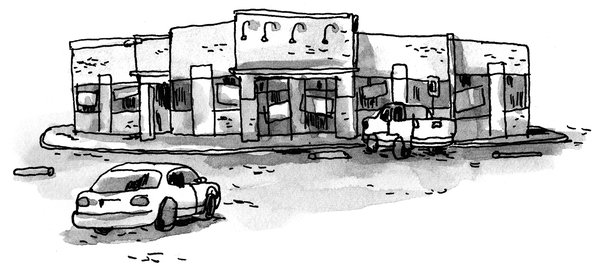Brookings fellow reports a fundamental market shift toward housing in cities and inner-ring suburbs.
 “It was predominantly the collapse of the car-dependent suburban fringe that caused the mortgage collapse.” So writes Brookings Institution senior fellow Christopher Leinberger in his recent New York Times Op-Ed piece, “The Death of the Fringe Suburb.”
“It was predominantly the collapse of the car-dependent suburban fringe that caused the mortgage collapse.” So writes Brookings Institution senior fellow Christopher Leinberger in his recent New York Times Op-Ed piece, “The Death of the Fringe Suburb.”
(NOTE: NY Times illustration at left by Victor Kerlow.)
Leinberger explains that the housing downturn has hardly been uniform in its impact. Instead, we’ve witnessed an absolute cratering of demand in the outer ring suburbs, those areas where speculative, car-oriented development of cookie-cutter McMansions was most explosive before 2008. Things have gotten so bad out there that many suburban fringe houses are now priced at below replacement value according to Leinberger.
Meanwhile, walkable neighborhoods in the urban core and inner-ring suburbs have become bastions of relative health. And this is reflected in real estate values. Back in the late ‘90s, the most expensive housing per SF was in the high-end outer suburbs, according to Leinberger. “Today, the most expensive housing is in the high-density, pedestrian-friendly neighborhoods of the center city and inner suburbs.”
Leinberger is not alone in drawing connections between sprawl and recession, or compact urban form and economic health. As we reported last December in our blog post, “The Urban Growth Boundary has been good to us,” the Home Builders Association has begun to recognize the link, too. Portland Architecture’s Brian Libby wrote about the 2010 Home Builders Association of Metropolitan Portland’s annual forecast breakfast thusly:
“Tim Sullivan of John Burns Real Estate Consulting said at the breakfast that if not for the state’s strict land-use laws, Oregon might have suffered a fate more like Phoenix or Las Vegas: massive overbuilding that has created an economic black hole, especially in the once big-booming Sin City. ‘It’s because of your urban growth boundary,’ Sullivan said. ‘You’re the antithesis of Phoenix, where you can build anything, anywhere at any time.'”
Portland’s recession would likely have been much worse with unbridled sprawl and its concomitant overheated speculation.
So we’re fortunate that Portland was ahead of the curve. But what Leinberger is finding is that the market itself is shifting the U.S. away from its unhealthy suburban sprawl diet, and in fundamental, lasting ways.
“Simply put, there has been a profound structural shift — a reversal of what took place in the 1950s, when drivable suburbs boomed and flourished as center cities emptied and withered,” writes Leinberger.
What’s behind the shift? Baby boomers and their millennial children – empty nesters on the one hand, and young adults just getting started on their own on the other – who together now make up 50% of the US population. Both groups, according to a recent National Association of Realtors study cited by Leinberger, want to live in walkable, vibrant neighborhoods, not car-oriented developments. And they’re not alone. In fact, only 12% of future homebuyers want fringe suburban housing anymore, according to the same study.
“This lack of demand all but guarantees continued price declines,” writes Leinberger. “Boomers selling their fringe housing will only add to the glut. Nothing the federal government can do will reverse this… The good news is that there is great pent-up demand for walkable, centrally located neighborhoods in cities like Portland, Denver, Philadelphia and Chattanooga, Tenn.”
On the policy front, Leinberger calls for a reinvestment in cities and inner-ring suburbs to lay the foundation for economic recovery.
“It is time to build what the market wants: mixed-income, walkable cities and suburbs that will support the knowledge economy, promote environmental sustainability and create jobs,” concludes Leinberger.
“Hear, hear!” we say, both for public policy and as business strategy for Hammer & Hand. After all, we’ve staked the claim that serving as a steward of Portland’s built environment is economically viable, even profitable… and more importantly, that our services represent smart investments for our clients. So far both have been true, particularly in the years since 2008. Taken together, residential remodels, commercial tenant improvements, new infill houses, accessory dwelling units, universal design retrofits and home energy remodels represent a big reinvestment in the built environment at the core of our fair metropolis. Leinberger’s opinion piece is another affirmation that these efforts are aligned with a “new normal” that is emerging from the ashes of the Great Recession, one that brings with it promises of greater economic sustainability and environmental health.
– Zack
Back to Field Notes